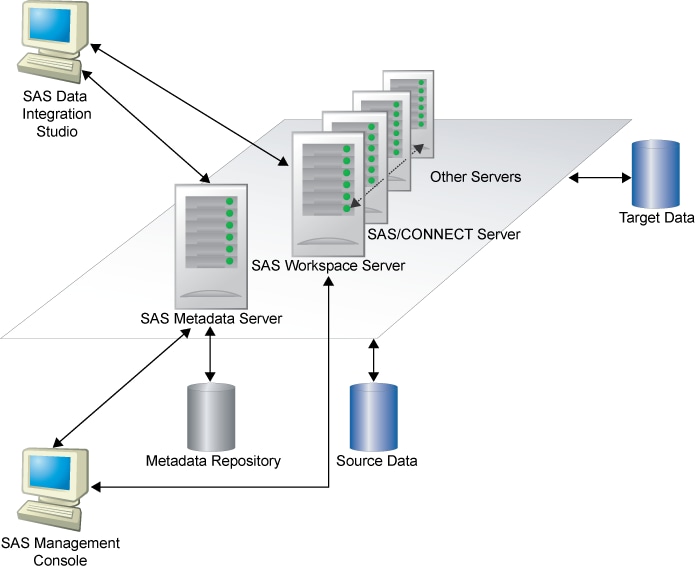A Basic Data Integration Environment
Overview of a Data Integration Environment
Administrators
use SAS Management Console to connect to a SAS Metadata Server. They
enter metadata about servers, libraries, and other resources on your
network and save this metadata to a repository. SAS Data Integration
Studio users connect to the same metadata server and register any
additional libraries and tables that they need. Then, they create
process flows that read source tables and create target tables in
physical storage.
SAS Data Integration Studio
Servers
SAS Application Servers
When the SAS Intelligence Platform was installed at your site,
a metadata object that represents the SAS server tier in your environment
was defined. In the SAS Management Console interface, this type of
object is called a SAS Application Server. By default, this application
server is named SASApp.
A SAS
Application Server is not an actual server that can execute SAS code
submitted by clients. Rather, it is a logical container for a set
of application server components, which do execute code––typically
SAS code, although some components can execute Java code or MDX queries.
For example, a SAS Application Server might contain a workspace server,
which can execute SAS code that is generated by clients such as SAS
Data Integration Studio. A SAS Application Server might also contain
a stored process server, which executes SAS Stored Processes, and
a SAS/CONNECT Server, which can upload or download data and execute
SAS code that is submitted from a remote machine.
The following
table lists the main SAS Application Server components and describes
how each one is used.
Database Management System (DBMS) Servers
SAS Data
Integration Studio uses a SAS Application Server and a database server
to access tables in database management systems such as Oracle and
DB2.
When you
start the Register Tables wizard or the New Tables wizard, the wizard
tries to connect to a SAS Application Server. You are then prompted
to select an appropriate database library. SAS Data Integration Studio
uses the metadata for the database library to generate a SAS/ACCESS
LIBNAME statement, and the statement is submitted to the SAS Application
Server for execution.
The SAS/ACCESS
LIBNAME statement specifies options that are required to communicate
with the relevant database server. The options are specific to the
DBMS to which you are connecting. For example, here is a SAS/ACCESS
LIBNAME statement that can be used to access an Oracle database:
libname mydb oracle user=admin1 pass=ad1min path='V2o7223.world'
Enterprise Resource Management (ERM) Systems
Optional Composite
Software provides access to ERM systems such as Siebel, PeopleSoft,
Oracle Applications and Salesforce.com. An optional data surveyor
wizard provides access to SAP ERM systems. For details about Composite
Software and the data surveyor wizard for SAP ERM systems, see the SAS Intelligence Platform: Data Administration Guide.
Libraries
In SAS software, a
library is a collection of one or more files that are recognized by
SAS and that are referenced and stored as a unit. Libraries are critical
to SAS Data Integration Studio. You cannot begin to enter metadata
for sources, targets, or jobs until the appropriate libraries have
been registered in a metadata repository.
Accordingly,
one of the first tasks in a SAS Data Integration Studio project is
to specify metadata for the libraries that contain sources, targets,
or other resources. At some sites, an administrator adds and maintains
most of the libraries that are needed, and the administrator tells
SAS Data Integration Studio users which libraries to use.
Additional Information
For more
information about setting up a data integration environment, administrators
should see Administrative Documentation for SAS Data Integration Studio.
